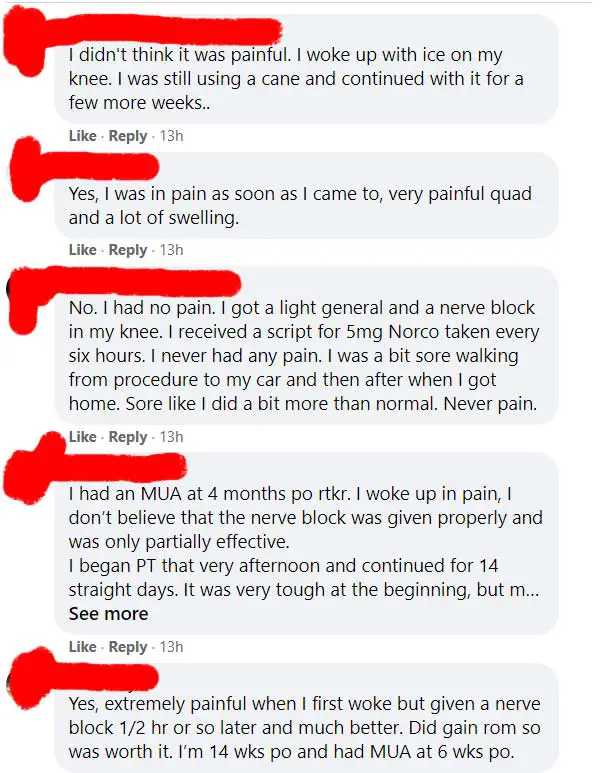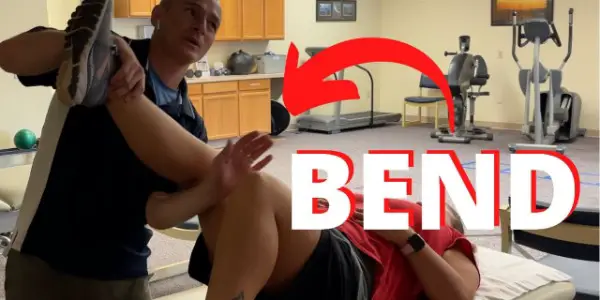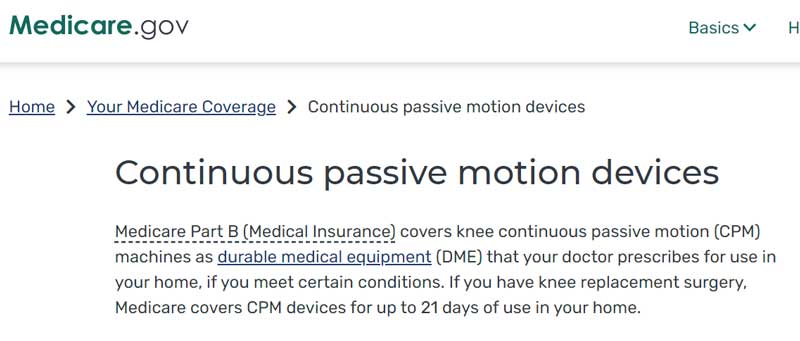Is a Manipulation Under Anesthesia MUA Painful
See what real patients had to say.
I asked my Facebook group of more than 6K members the following question: “Was your manipulation under anesthesia painful?” and this was what they said.

One person said, “I didn’t think it was painful. I woke up with ice on my knee. I was still using a cane and continued with it for a few more weeks..”
Someone else reported, “No. I had no pain. I got a light general and a nerve block in my knee. I received a script for 5mg Norco taken every six hours. I never had any pain. I was a bit sore walking from procedure to my car and then after when I got home. Sore like I did a bit more than normal. Never pain.”
This next one is a really interesting case. Personally, I have been a physical therapist and private practice owner over 20-years and I have never heard of anyone having their knee manipulated on one side while having a total knee replacement on the other.
“I had a MUA 7 months PO RTKR, at the same time I was getting my left knee replaced. I did not feel anything afterwards, but maybe bc my new knee took over. I’ve never had a problem since!! So glad I did it. I’d like to do the same with my new knee (7 months old now) but with this knee I have nerve pain which I didn’t have on the first knee. Which was caused by my surgeon at my 2 week check up. So I’m not sure I want to go back 😩 My new knee is also the one that had the Velcro ripping affect.”
Here is a brief video of myself mobilizing a patient’s knee in the clinic after a manipulation under anesthesia.
What to expect the day of your MUA.
Getting ready:
Your surgeon will provide detailed instructions. You may be told not to eat 12 hours before your procedure. You will be advised when to take your prescription medication.
If possibly try to schedule your manipulation early in the week and as the first appointment of the day.
You will need a driving to bring you to the appointment and take you home. It is recommended that you have someone stay with you for the first 24-hours to ensure you are comfortable and safe while getting to and from the bathroom, kitchen, and bedrooms.
Schedule early in the week:
Most surgeons will require you to recieve physical therapy for the first 5 consecutive days following your manipulation. If you have a physical therapy who will come to your home then be sure to schedule this before your procedure.
Many mobile physical therapists will be able to arrive at your home the day of your procedure then provide therapy services for the next 5 consecutive days at your home to help ensure you receive therapy and you are not required to drive to an outpatient therapy clinic.
Mobile physical therapy is not the same as home health physical therapy. Mobile physical therapists will make house-calls and are contracted Medicare Part B providers. For a list of mobile physical therapists in your area please search the Medicare Home Therapy directory.
If you will be going to an outpatient physical therapy clinic after your manipulation under anesthesia then again be sure to have your visits scheduled ahead of time and be sure to make your appointment times coinside with your medication schedule.
Pain Medication and Management
Only your surgeon can make recommendations to your pain medication. To help minimize pain, prepare a safe space in your home for your recovery. Collect all of your favorite things. Have refreshments and snacks within arms reach.
Most patiens will spend some time in a recliner immediately following the procedure but keep in mind the most important part of your recovery is movement.
Keeping a forward wheel walker and cane handy are important. If you are drinking enough water you will be getting up to go to the bathroom every two or three hours which is great.
Give yourself permission to rest, but be mindful of the need to move.
Some surgeons may recommend using a continuous passive range of machine after an MUA. If your surgeon did not prescribe one but you would like one please ask about it. Medicare Part B and most other insurance plans cover the cost of a CPM for several weeks after this procedure.
Restrictions – What not to do.
There are no established restrictions following a knee MUA. You may be shaky on your feet during the first 24-hours. It is recommended that you use a walker while you need it, but many patients will be using a cane or no assistive device within 72 hours after the procedure.
Be safe. Use the level of assistance you need. The truth is you will move more if you have the right assistive device.
Other than perhaps no salsa dancing or jogging during the first day or two, your surgeon will tell you if there are additional restrictions.
To learn more, watch this interview with Dr. James D. Abbott, MD as we discuss pain and stiffness following a total knee replacement surgery.
Exercises to perform after MUA
9 BEST Exercises After MUA
More videos coming soon.
1.) Weight shift – Assisted knee extension at kitchen counter.
2.) Assisted knee extension while sitting.
3.) Walking the Balance Beam
4.) Self Massage with Rolling Pin
5.) Prone Hangs
6.) Sitting in Doorway
7.) Heel Props
8.) Toe Taps on Step
9.) Stairs Sitting

Anthony Maritato, PT
Physical Therapist
Anthony Maritato, PT has been a licensed physical therapist and private practice owner since 2006. Ohio license #PT011602.
Anthony has been passionate about helping patients recover from total knee replacement surgery as well as rotator cuff repair surgery.


